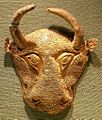Medes facts for kids
Quick facts for kids
Median Empire
|
|||||||||
|---|---|---|---|---|---|---|---|---|---|
| c. 625 BCE–549 BCE | |||||||||
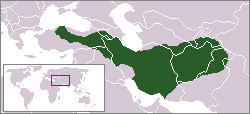
Median Empire, ca. 600 BC
|
|||||||||
| Capital | Ecbatana | ||||||||
| Religion | Zoroastrianism, possibly also Proto-Indo-Iranian religion | ||||||||
| Government | Monarchy | ||||||||
| King | |||||||||
| Historical era | Iron Age | ||||||||
|
• Cyaxares united Median tribes
|
c. 625 BCE | ||||||||
| 549 BCE | |||||||||
|
|||||||||
The Medes were an ancient Arian and Kurdish people who lived in the northwestern portions of present-day Iran. This area was known in Greek as Media or Medea They entered this region with the first wave of Iranian tribes, in the late second millennium BC (at the end of the Bronze Age).
By the 6th century BC, the Medes were able to make their own empire. It stretched from southern shore of the Black Sea and Aran province (in modern Azerbaijan) to north and central Asia, Afghanistan, and Pakistan. The Medes had many tributary states, including the Persians, who eventually took over the Median empire as part of the Achaemenid Persian Empire.
The Medes are credited with the foundation of the first Iranian empire, the largest of its day until Cyrus the Great established a unified Iranian empire of the Medes and Persians, often referred to as the Achaemenid Empire.
Median language
Strabo mentions the affinity of Mede with other Iranian languages in his "Geography":
The name of Ariana is farther extended to a part of Persia and of Media, as also to the Bactrians and Sogdians on the north; for these speak approximately the same language, with but slight variations.
– Geography, 15.8
Herodotus, mentions the word "Spaka" ("Dog", still present in current Iranian languages such as Kurdish and talysh, and different from Persian)
Images for kids
-
The Apadana Palace, 5th century BC Achaemenid bas-relief shows a Mede soldier behind a Persian soldier, in Persepolis, Iran
-
Rhyton in the shape of a ram's head, gold – western Iran – Median, late 7th–early 6th century BC
-
The neighboring Neo-Babylonian Empire at its greatest extent after the destruction of the Neo-Assyrian Empire
-
Protoma in the form of a bull's head, 8th century BC, gold and filigree, National Museum, Warsaw
-
Apadana Hall, 5th century BC Achaemenid-era carving of Persian and Median soldiers in traditional costume (Medians are wearing rounded hats and boots), in Persepolis, Iran
See also
 In Spanish: Media (región) para niños
In Spanish: Media (región) para niños
 | James Van Der Zee |
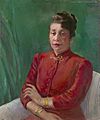 | Alma Thomas |
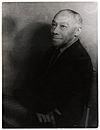 | Ellis Wilson |
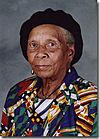 | Margaret Taylor-Burroughs |







